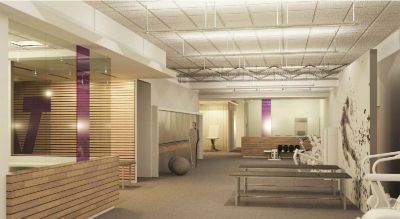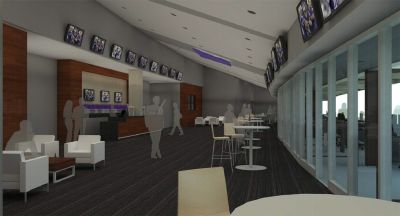
August 29, 2013
A Special Section of
DJC.COM
| Stories |
|
|
|
August 29, 2013 Project team's playbook focuses on lean construction
Howard S. Wright, a Balfour Beatty company, built out several spaces at the newly renovated Husky Stadium, including the 30,000-square-foot Sports Medicine Clinic. Completed in July, the facility is underneath the stadium's south stands and features 39 exam rooms, four treatment rooms, two X-ray rooms, 21 office and consultation rooms, and rehabilitation space. The clinic provides medical services to the University of Washington football team, other UW varsity sports teams, and the public. Is there a leaner way to construct? That question was asked by project team members Chris Martindale, Jordan Cash, John Hansen and Brian Lemmon, who used lean construction principles throughout the project to help eliminate waste and non-value adding components during construction. Part of finding that answer was for the team to conduct an eight-hour 'lean event,' which brought together the construction team, metal framing subcontractor and structural engineer to find cost and time savings. One of the main goals at this lean event was to find another solution to the structural plan, which initially called for metal-framed bracing to tie the interior walls to the structure above. 'By bringing everyone together in one room -- who were determined to find an answer -- we were able to design self-supporting structural walls that do not need additional support or bracing from the building's structure,' said Martindale, project executive for Howard S. Wright. This process not only simplified clash detection, allowing for the MEP components to run freely without obstruction from the lower wall braces, it also saved the project thousands of dollars and countless hours of labor. Another goal was to find a solution that would reduce the size of the metal studs for the 33-foot-tall walls in the locker room. The team found a way to install metal-framed ceilings at 15 feet that could act as a diaphragm for the walls. This significantly reduced the size of the metal studs that would have extended to the bottom of the bleacher seating above, lowered the safety hazards of working at a height of 33 feet, and reduced patching work that would have been required at that height for fireproofing and thermal insulation.
Image courtesy of Gunsul + Iverson
[enlarge]
The Sports Medicine Clinic is
underneath the stadium’s south
grandstands. It has 39 exam
rooms, four treatment rooms,
two X-ray rooms, 21 office and
consultation rooms, and
rehabilitation space.
Image courtesy of 360 Architecture
[enlarge]
Twelve Touchdown Terrace Patio Suites can be found at the field level on the east end zone.
Other solutions accomplished by the team include the installation of shared supports for acoustical ceiling tile and MEP systems. This also reduced the number of attachments made to the structure, increasing productivity and reducing costs. The team also engineered an overhead support system for the imaging equipment that did not need to extend to the overhead structure. This was beneficial in that it was a less expensive solution. It also eliminated the miscellaneous steel typically used in this scenario, which reduced common MEP conflicts that are often present with this type of imaging system installation. Overall, the outcome of this lean event produced a number of results that were beneficial to the team as well as the client. 'We are constantly striving to provide greater value to our clients by leveraging lean processes, which made this lean event outcome particularly rewarding,' Martindale said. Additional lean methodologies were used that helped the job become a 'model project' that demonstrates the newest in construction technology. For example, the entire team used laser scanners for data points and layout, as well as building information modeling, SmartBoxes, and iPads to increase efficiency and productivity. Some of these same lean methodologies were applied at three additional projects constructed by Howard S. Wright at Husky Stadium: Touchdown Terrace Patio Suites Construction cost: $1.4 million Completion: Aug. 8 Description: Measuring 4,800 square feet, the Touchdown Terrace Patio Suites are at the field level on the east end zone. A total of 12 covered, open-air suites were built that are configured with eight seats. The setting is designed to provide Husky fans with some of the closest action to the game than anywhere else in the stadium. The project scope included the addition of kitchen equipment and an expanded club area that is designed to replicate a sports bar type of experience. Don James Suite renovations Construction cost: $1.5 million Completion: July 31 Description: Renovations to the Don James Suite -- which is a 12,000-square-foot space on the fourth level of the north side of the stadium -- included overall modernizations such as a new stationary bar, stone fireplace, kitchen equipment, wood flooring and carpeting, wood ceiling, glass handrails, remodeled bathrooms with stone tile and granite countertops, new wood drink rails on the south viewing wall and MEP upgrades. Football Operations Center Construction cost: $10 million Completion: Aug. 7 Description: The 83,000-square-foot Football Operations Center is at the west end of the new stadium and features a glass entryway. The two-story center includes offices for coaching staff, a player's lounge, team meeting rooms with theater-style seating, and a balcony overlooking the field on the upper level. A new locker room, training rooms, weight rooms and three Hydroworx therapy pools are on the lower level. Dan Peyovich is Washington Division president of Howard S. Wright, a Balfour Beatty company.
|


